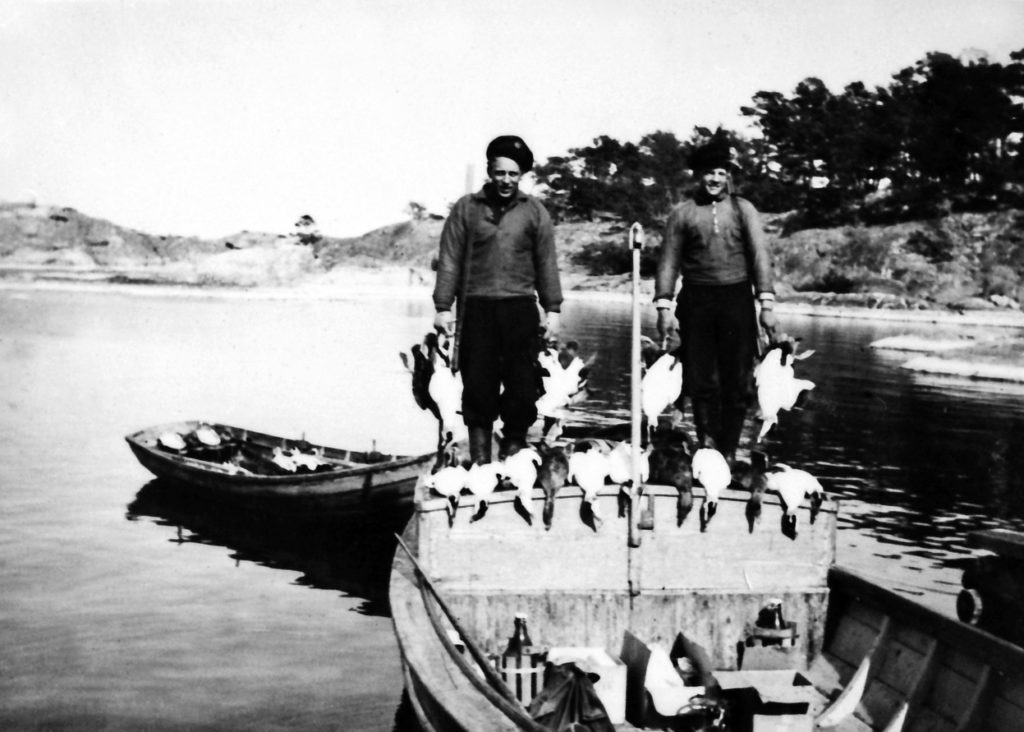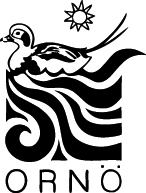· Start · Next sign · Previous sign · Swedish
GOOSANDER BIRD HOUSE – BIRD AND EGG HUNTING
Up ahead you should be able to see a merganser bird box. Goosanders are beautiful diving ducks, and the females, called “skräckan” in Swedish, often nest in hollow trees. Or they may use a man-made goosander bird house, like this one.
In earlier days, Ornö island inhabitants hunted seabirds to supplement their fare and their income.
In the Country Law of Magnus Eriksson, dating from the mid-1300s, hunting “big game”, that is, moose, deer and roe deer was reserved for the king and the nobles. In 1664, small wild game and woodland birds were also added to the list of game reserved for the privileged classes. However, the island dwellers kept their right to hunt seabirds.
In the 1600s, those who entered Stockholm from the archipelago with goods paid a toll. Records from the Little Toll at Blockhusudden show that in 1624, Ornö islanders paid duty on barrels of salted and dried fish, relatively small amounts of butter and meat, as well as 173 common eider females, 31 scoters and 100 pairs of long-tailed duck.
For a long time, seabirds were hunted using airnets – large nets stretched across a suitable sound to catch birds. Rigging the nets and throwing them accurately to catch as many birds as possible was exacting and skilled work.
Later, seabirds were also hunted with shotguns, using decoys. Decoys can be carved in wood to look like the bird you are hunting. The most lifelike type is a feather decoy – a shot bird with the skin preserved and the body stuffed with ferns and mounted on a board. The decoy is placed among the reeds, or at the water’s edge to lure the birds. A good hunter can even mimic the right bird call to better attract the game.
“Äggskattning”, taking birds’ eggs, also played an important role in the food supply.

Happy seabird hunters Pelle Jansson and Karl-Harry Andersson, 1940s.
Eiders nest on the ground, making their eggs easy to reach. Seagull and gull eggs are also easy to reach, but were only good for use in pancakes. Female goosanders build their nests high up in hollow trees, and as different from other seabirds, goosanders hatch new eggs once her eggs are gone. This is why bird houses like this one were put up, which could be easily emptied of eggs without affecting the goosander population.
Many seabird populations have declined in recent years, in particular the eider. The goosander is not considered to be endangered and has a stable spread across the northern hemisphere. According to regulations, goosander, eider, long-tailed duck and common scoter may be hunted in autumn and winter, but in actuality, there is very little hunting. Nowadays, taking eggs from any birds’ nests in nature is prohibited.
Lervassa Trail was produced by Ornö Museum in collaboration with Stockholms läns Hembygdsförbund and with funding from the Swedish National Heritage Board.

